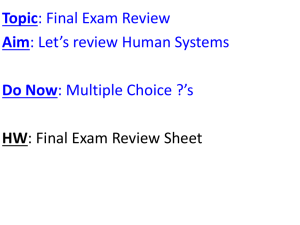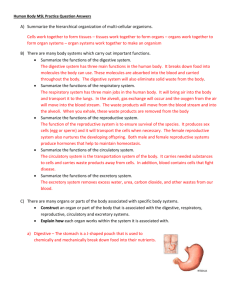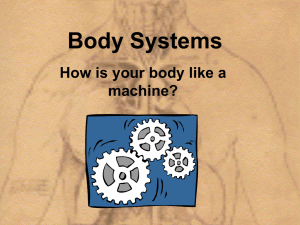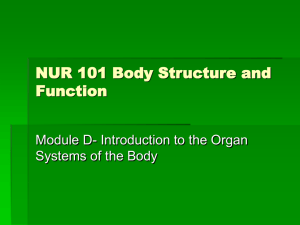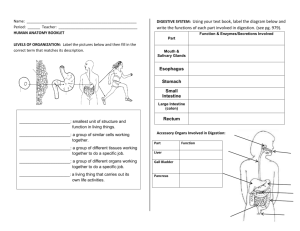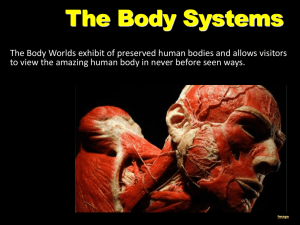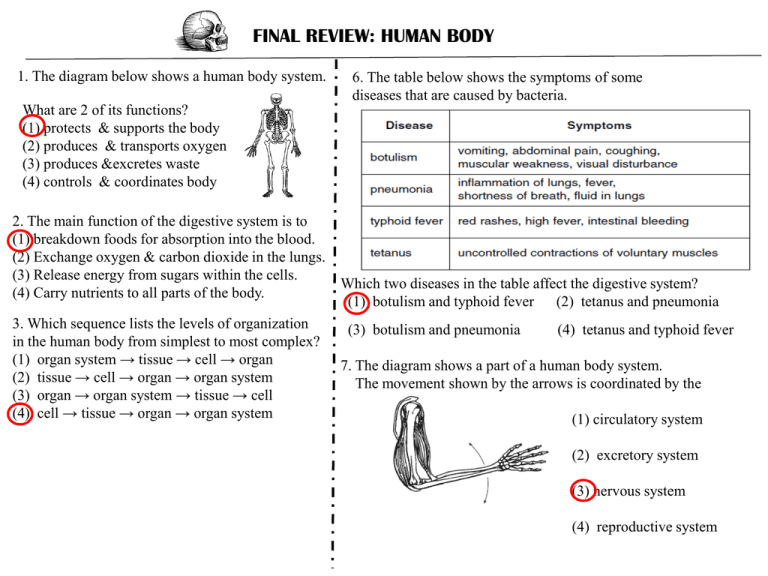
FINAL REVIEW: HUMAN BODY
1. The diagram below shows a human body system.
6. The table below shows the symptoms of some
diseases that are caused by bacteria.
What are 2 of its functions?
(1) protects & supports the body
(2) produces & transports oxygen
(3) produces &excretes waste
(4) controls & coordinates body
2. The main function of the digestive system is to
(1) breakdown foods for absorption into the blood.
(2) Exchange oxygen & carbon dioxide in the lungs.
(3) Release energy from sugars within the cells.
Which two diseases in the table affect the digestive system?
(4) Carry nutrients to all parts of the body.
(1) botulism and typhoid fever (2) tetanus and pneumonia
3. Which sequence lists the levels of organization
(3) botulism and pneumonia
(4) tetanus and typhoid fever
in the human body from simplest to most complex?
(1) organ system → tissue → cell → organ
7. The diagram shows a part of a human body system.
(2) tissue → cell → organ → organ system
The movement shown by the arrows is coordinated by the
(3) organ → organ system → tissue → cell
(4) cell → tissue → organ → organ system
(1) circulatory system
(2) excretory system
(3) nervous system
(4) reproductive system
4. Which three systems of the human body
function together to move and control body parts?
(1) nervous, skeletal, and muscular
8. Which two body systems most directly cause the
arm above to bend?
(2) muscular, endocrine, and excretory
(1) skeletal and muscular
(3) digestive, excretory, and reproductive
(2) reproductive and endocrine
(4) circulatory, endocrine, and respiratory
(3) respiratory and excretory
(4) nervous and digestive
5. The labeled organs in the diagram below are part
of which human body system?
9. The endocrine system produces chemicals that
affect organ functions. These chemicals are called
(1) respiratory
(1) nutrients
(3) microbes
(2) digestive
(2) hormones
(4) wastes
(3) endocrine
(4) circulatory
10. Which substance provides humans with their
main source of energy?
(1) food
(3) water
(2) carbon dioxide
(4) chlorophyll
20. During breathing, the lungs absorb oxygen, which is
used by cells to carry out the process of
(1) respiration
(3) photosynthesis
(2) secretion
(4) excretion
11. When a human exercises, sweat forms on the skin.
Sweating is an example of the human body’s ability to
(1) recycle nutrients (3) obtain water for nourishment
(2) respond to the environment (4) make more energy
21. Running is an activity that causes the cells in the
muscular system to use oxygen at a faster rate. Which system
responds by delivering more oxygen to these cells?
(1) digestive
(3) circulatory
(2) nervous
(4) endocrine
12. Nutrients from digested food enter the blood stream
through the process of
(1) absorption
(3) respiration
(2) elimination
(4) secretion
13. In which process is oxygen used to release energy
stored in food?
(1) photosynthesis
(3) digestion
(2) respiration
(4) reproduction
14. The kidneys, which remove dissolved wastes from
the blood, are organs of the
(1) endocrine system (3) skeletal system
(2) excretory system (4) nervous system
22. In which human body system are hormones produced?
(1) respiratory
(3) nervous
(2) endocrine
(4) digestive
23. Which human body systems are directly involved in
reflex actions, such as knee jerk, blinking, and jumping when
startled?
(1) circulatory and respiratory
(2) digestive and excretory
(3) nervous and muscular
(4) reproductive and skeletal
15. Which two systems of a rabbit’s body must be
working together for the rabbit to run away from a fox?
(1) digestive & endocrine (3) muscular & skeletal
(2) reproductive & nervous (4) excretory & respiratory
16. Fats are important nutrients because they
(1) provide genetic information
(2) contain stored energy
(3) are used in photosynthesis
(4) maintain bone density
17. Which choice is the result of abnormal cell division?
(1) cancer
(3) infection
(2) pregnancy
(4) extinction
18. To provide energy for work, all cells need
(1) chloroplasts
(2) nutrients
(3) atmospheric nitrogen
(4) carbon dioxide
19. Cells are to tissues as tissues are to
(1) microbes
(3) systems
(2) organs
(4) bacteria
24. When do organs begin to develop in humans?
(1) in the sperm cell before fertilization
(2) before fertilization and after birth
(3) in the egg cell after fertilization
(4) after fertilization and before birth
25. Which body system is responsible for the
elimination of liquid and gaseous wastes?
(1) nervous
(3) excretory
(2) skeletal
(4) digestive
26. Which factor has the least effect on a person’s
metabolism?
(1) exercise
(3) intelligence
(2) hormones
(4) diet
27. Tissue is composed of a group of
(1) similar cells working together
(2) different organs working together
(3) organ systems working together
(4) nuclei in a cell working together
28. Which term describes an organism’s ability to
maintain a stable internal environment?
(1) reproduction
(3) locomotion
(2) extinction
(4) regulation
*Base your answers to questions 29-32 on the diagram below showing human reproduction.
SPERM CELL
29. Identify the sex cell shown at A. ___________________________
30. Identify the sex cell shown at B.___________________________
EGG CELL
31. Identify the reproductive process that is occurring at C.______________________________
FERTILIZATION
32. Identify the process that is occurring between E and F._______________________________
MITOSIS
*Base your answers to questions 33-34 on the diagrams, which shows systems in humans and plants.
33. Select one structure labeled in the human
system & explain how it contributes to the
way the human system functions.
____________________________________
HEART-BLOOD CIRCULATION
34. Select one structure labeled in the plant
system & explain how it contributes to the
way the plant
system functions.
____________________________________
LEAVES-PHOTOSYNTHESIS
*Base your answers to questions 35-37 on the diagram below, which shows a model of sexual reproduction.
The lines in each cell represent genetic material (chromosomes).
B
35. Which letter in the diagram represents a female sex cell? _____
FERTILIZATION
36. Which process is occurring at C? ________________________________
CHROMOSOME TRANSFER
37. What evidence in the diagram shows that sexual reproduction occurred?_____________________________
----------------------------------------------------------------------------------------------------------------------38. The diagram below represents a magnified view
of an air sac in the human lung. The white arrows
indicate blood flow.
39. What is the main function of the circulatory
system?
(1) secrete enzymes
(3) produce hormones
(2) digest proteins
(4) transport materials
40. Infectious diseases are caused by
(1) allergies
(3) chemical spills
(2) vitamin deficiencies (4) microorganisms
Which two systems are interacting in this diagram?
(1) skeletal and muscular
(2) nervous and endocrine
(3) reproductive and digestive
(4) respiratory and circulatory
41. If a species is no longer able to reproduce, it will
(1) adapt to its environment
(2) become immune to disease
(3) become extinct
(4) increase its population
42. Three different human cells are shown below.
Which process occurs in all of these cells?
(1) metamorphosis
(3) reproduction
(2) locomotion
(4) photosynthesis
43. Which unit is used to indicate the amount of
energy in food?
(1) ounce (2) degree
(3) calorie (4) gram
44. The main function of hormones in the human
body is to
(1) destroy microbes
(3) transport blood
(2) regulate body functions (4) store energy
45. The diagram below shows several organs in the
human digestive system.
Explain two ways that food is
changed as it passes through
the digestive system.
MECHANICAL &
(1)_______________________
CHEMICAL DIGESTION
BREAKDOWN OF FOOD
(2)_______________________
MOLECULES
46. What is the result of cellular respiration?
(1) Energy for cell processes is released.
(2) Oxygen is released for photosynthesis.
(3) Cells undergo decomposition.
(4) Nutrients are excreted to prevent the buildup
of body fat.
*Base your answers to questions 47-48 on the diagram
below, which shows four stages in the development of a
human after fertilization.
47. Which process must occur between A & D?
(1) mutation
(3) cell division
(2) sexual reproduction
(4) extinction
48. Which sequence of development is correct?
(1) fertilized egg → tissues → organ systems → organs
(2) fertilized egg → organ systems → organs → tissues
(3) fertilized egg → organs → tissues → organ systems
(4) fertilized egg → tissues → organs → organ systems
49. Humans have several organ systems that allow
them to carry on all life activities. Complete the
chart below by identifying one organ system that is
responsible for each life activity listed. The first row
has been completed as an example.
RESPIRATORY
EXCRETORY
CIRCULATORY
REPRODUCTIVE
54. What is the major function of the human excretory system?
(1) eliminate waste materials
(2) respond to stimuli
(3) break down food mechanically
(4) absorb nutrients from food
55. The interaction of the skeletal & muscular systems
to produce locomotion is coordinated by which body system?
(1) circulatory
(3) nervous
(2) excretory
(4) respiratory
56. Infections may be caused by
(1) mutations
(3) toxic substances
(2) microorganisms
(4) climate changes
57. The chart below identifies the function of several organs
found in a human body system.
MUSCULAR
50. Running to escape danger is an action that
requires the nervous system to coordinate the
interaction of which two body systems?
(1) digestive and endocrine
(2) muscular and skeletal
(3) reproductive and excretory
(4) circulatory and digestive
51. A broken bone heals through the process of
(1) adaptation
(3) cell division
(2) mutation
(4) chemical digestion
Which human body system performs these functions?
(1) skeletal
(3) circulatory
(2) digestive
(4) respiratory
58. The amount of sugar in blood is controlled by the release of
a hormone called insulin. This process is an example of
(1) depletion
(3) regulation
(2) digestion
(4) excretion
52. Which diagram represents one type of human tissue?
53. Which process is shown by the equation below?
(1) circulation
(2) reproduction
(3) locomotion
(4) respiration
62. Insulin and glucagon are hormones that affect blood
sugar levels. The diagram below shows the feedback
system used by the human body to increase & decrease
blood sugar levels.
59. Scurvy is a disease that sailors often got on long voyages.
Scurvy could be prevented by eating oranges
& lemons. This suggests that scurvy is caused by
(1) exposure to sea air
(3) a microorganism
(2) a nutritional deficiency (4) lack of exercise
60. The sum of all chemical reactions in the human
body is known as
(1) feedback
(3) dynamic equilibrium
(2) metabolism (4) biological adaptation
61. Which human system produces sperm or egg cells?
(1) digestive system
(3) respiratory system
(2) nervous system
(4) reproductive system
63. Complete the table below by identifying the human
organ system that performs each function listed. The
first row has been completed.
CIRCULATORY
This feedback system is one way that the human body
(1) circulates gases
(3) destroys viruses
(2) maintains equilibrium
(4) transports nutrients
DIGESTIVE
RESPIRATORY
*Base your answers to questions 64-65 on the diagram below that represents a human organ system.
Arrows show the directions of blood flow. Letters A & B represent locations in this system.
64. Identify the human organ system responsible for
the movement of blood shown in the diagram.
__________________
system
CIRCULATORY
65. State one reason why blood at location B contains more
oxygen than blood at location A.
IT HAS JUST LEFT THE LUNGS.
__________________________________________
66. The table below lists
two structures in the human
digestive system and two
functions of each. Complete the
table by circling the type of
digestion represented by each
function described.



